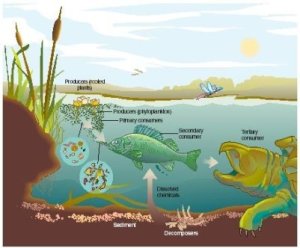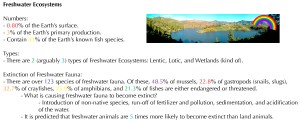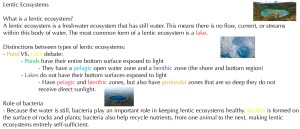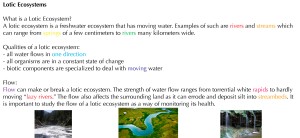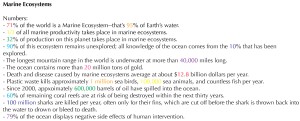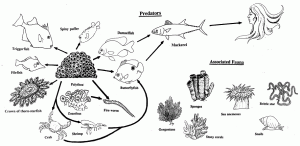Science
The science behind ecosystems, specifically those in the ocean, can be incredibly complex–involving many theories, opposing positions, and facts that are difficult to fully comprehend. Here you can find some of the science–of both the ocean’s hisory and the current state of the oceanic ecosystem–presented in a manner that is broken down for your better understanding.
Types of Ecosystems:
Information about Aquatic Ecosystems:
Chart Explaining Aquatic Ecosystems:
Information about Freshwater Ecosystems:
Information about Lentic Ecosystems:
Information about Lotic Ecosystems:
Information about Wetlands:
Information about Marine Ecosystems:
Chart with types of fish found in Marine Ecosystems:
The Current State of Aquatic Ecosystems:
What can you do?
As we have seen, the ocean is more interconnected than we may have thought–and not just to itself, but to our decisions on land as well. The following is a list of things you can do–on land, from home–that has a significant impact on the ocean’s ecosystem.
1. Be aware of seafood choices. (This includes sushi!) Some species are more sustainable than others. According to the U.N. Food and Agriculture Organization, 80% of the world’s fisheries are overexploited or completely depleted. It’s more sustainable to eat from this list: Arctic Char, Catfish, Clams, Crab, Lobster, Mussels, Oysters, Salmon (choose Alaskan Salmon over Atlantic Salmon), Sardine, Scallops, Shrimp; It’s less sustainable to eat from this list: Chilean Sea Bass, Cod, Eel, Flounder, Grouper, King Crab, Mahi Mahi, Octopus, Snapper, Swordfish, Tilapia, Tuna, and Yellowtail.
A. Pregnant women: You have different seafood rules to pay attention to! Women who are pregnant, or may become pregnant, should not eat fish that is high in mercury (Swordfish, Tilefish, and King Mackrel).
2. Pay attention to plastic use. Poorly recycled plastic often ends up as ocean debris, which can lead to habitat destruction. It also is known for entangling marine life. It also can resemble food, tricking marine life into eating plastic bags and then choking. According to National Geographic, plastic killed an estimated 35,000 marine animals in 2012 alone. Carry a reusable water bottle, cut your soda can plastics, and use a reusable tote when shopping.
3. Avoid using pesticide and fertilizer. When pesticide and fertilizer is sprayed onto crops, lawns, plants, and gardens, it eventually runs off into the ocean. There are currently more than 400 documented dead zones (and probably many more that are undocumented). A dead zone is an area of the ocean where there is not enough oxygen for marine life to survive. There are dead zones the size of entire states in the Pacific and Atlantic Oceans! Acidification (from pesticides and fertilizer) makes oceanic ecosystems less viable, eventually destroying them entirely.
4. Buy safer household cleaning products. Everything that goes down your drain affects the ocean (even if you live far from the ocean!). Check the labels of your household cleaning products, if they have any of the following ingredients, throw them out and find an alternative: Nonylphenol exthoxylates (NPEs), Antibacterials, Ammonia, Butyl cellosolve, Chlorine bleach, d-limonene, Hydrochloric acid, Naptha, Petroleum, Phosphates, Sulfuric Acid. Too much to look for? Avoid this altogether by using homemade cleaners. Vinegar, baking soda, and lemon juice are known to solve many cleaning issues (just check Google!) and cause no negative side effects in the process.
4. Know where your jewelry and skincare products come from. Coral jewelry, tortoise shell hair accessories, and shark tooth necklaces are all stolen from the ocean–often in excursions that harm more than just the item selected, but the coral reefs, marine populations, and surrounding smaller ecosystems as well. Many moisturizers and sunscreens use shark-based squalene; use olive-based squalene instead!
5. Watch your pets. They can be a part of the conversation too! Make sure your cat food uses sustainable fish. Never flush cat litter down the toilet; it contains pathogens that, when flushed, enter the ocean and harm marine life. Choose fish that were not caught from the wild if you must have an aquarium. Never put those fish into the ocean should you decide you don’t want them; this messes up the way native species work in their individual ecosystems.
6. Help the sea turtles. Live by a beach where sea turtles hatch each season? Turn off white outdoor lights at night (or cover them with red cellophane). The sea turtles use the moonlight to guide their journey to the ocean and your outdoor mood lighting affects this process.
Information sourced from: Smithsonian Institution’s Ocean Planet: Writings and Images of the Sea by Peter Benchley and Judith Gradwohl, OCEANA, Mote Marine Laboratory, and The Oceanic Preservation Society.


